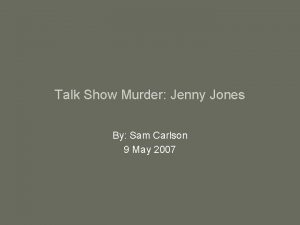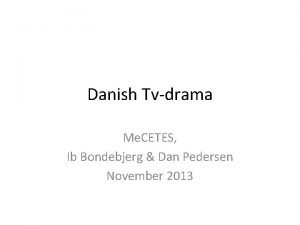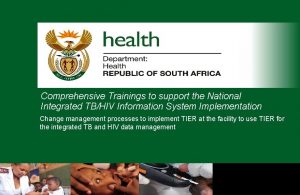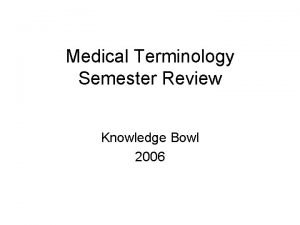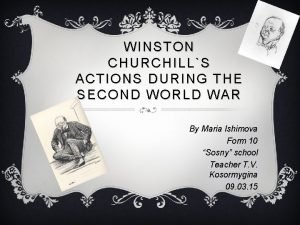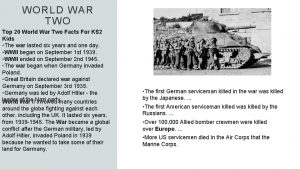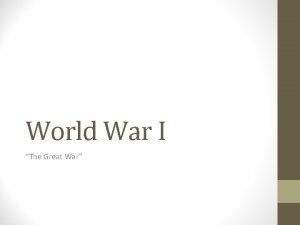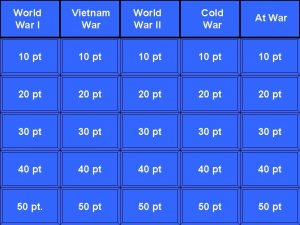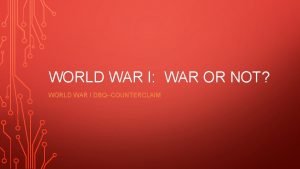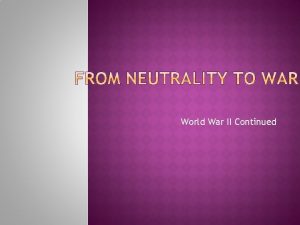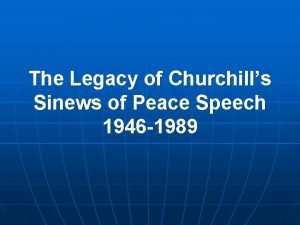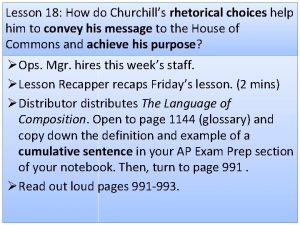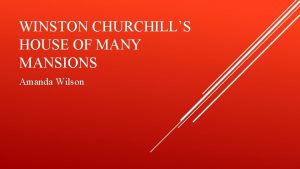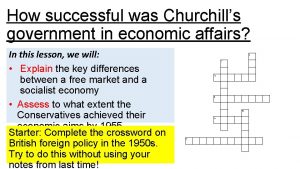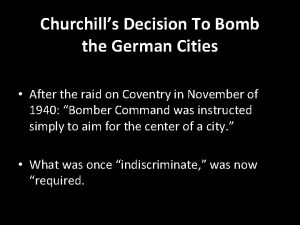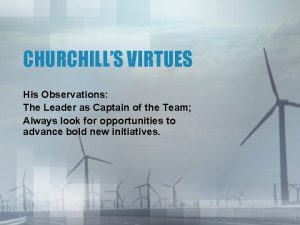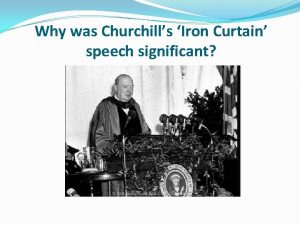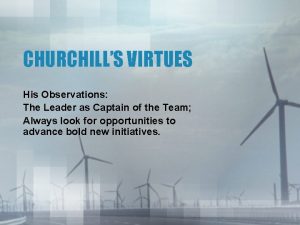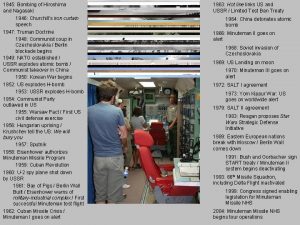World War Two two episodes to show Churchills





















- Slides: 21

World War Two: two episodes to show Churchill’s leadership We have already learnt about Winston Churchill when we looked at the Dunkirk rescue operation. Churchill was the Prime Minister of the UK for most of WW 2 and has been remembered for his courageous leadership. You are going to choose which event you’d like to study today either The Battle of Britain OR the D-Day Landings. We already looked at these events when we did an overview of WW 2, but today you are going to choose which one you’d like to study in greater depth.

You need to decide which event you would like to study in more depth today– you won’t have time to complete both! The Battle of Britain began after the Dunkirk evacuation. Hitler wanted to try and invade Britain, and so the RAF, British Government and ordinary people had to try and protect Britain! The D-Day landings, as they have been called, were the largest seaborne military invasion in History. They would lead to the liberation of Nazicontrolled France and eventually the Allied victory on the Western front.

Option 1: The Battle of Britain and the Blitz In the summer of 1940, Hitler decided to invade Britain. His plan was to take control of the English Channel by destroying the Royal Air Force and then to send German troops into Britain to take control. In July 1940, Hitler put this plan in to operation. The Luftwaffe (German air force) began making daily bombing raids, targeting British ships, ports, radar stations, airfields and aircraft factories. This became known as the Battle of Britain. As German losses mounted, Hitler decided that targeting British civilians could force the British to surrender. On 7 th September 1940, the Luftwaffe began bombing major cities. Casualties were high. On the first day of bombing, 430 people were killed and 1, 600 badly injured. Within a few weeks, the daily bombing raids had become nightly raids as Hitler decided this would cause more fear and make people weaker by preventing sleep. People in London slept in underground stations for protection. The British government tried to confuse the German bombers by enforcing a ‘blackout’. Street lamps were switched off, car headlights had to be covered and people had to hang black material in their windows at night so that house lights could not be seen. Going out at night could be dangerous during the blackout; cars crashed, people got run over, people fell off bridges. After May 1941, the bombing raids became less frequent as Hitler turned his attention to Russia. Nevertheless, the effects of the bombing were devastating. 60, 000 people lost their lives, 87, 000 were seriously injured and 2 million homes were destroyed.

German planes flew in groups which made them easy targets. Task One: Highlight German weaknesses and British strengths in the Battle of Britain. Some are a combination of the two! The German planes could only for 30 minutes at a time. There were fewer pilots in Britain, but The British fighter planes (the Hurricane and between landing and taking off again, they Spitfire) were faster and could move better only had short periods of rest while than the German planes were refuelled. The British had an experienced commander 1644 German pilots were killed, but only Chief Marshall Dowding who made effective 446 RAF pilots were killed in 1940. use of radar. Britain produced an average of 563 new Hitler’s bombing of factories didn’t work, planes each month between July and factories and industry carried on September 1940. producing war materials. Britain had RADAR. This meant the British Bad weather and the skill of the RAF pilots knew where the Germans would be made many of the Luftwaffe’s raids attacking and could meet them and stop unsuccessful. them. Goering, the commander of the Luftwaffe British pilots that fell could easily be had little understanding of tactics and replaced, whereas German pilots were underestimated the RAF. captured and sometimes killed.

German planes flew in groups which made them easy targets. Check your answers! The German planes could only for 30 minutes at a time. There were fewer pilots in Britain, but The British fighter planes (the Hurricane and between landing and taking off again, they Spitfire) were faster and could move better only had short periods of rest while than the German planes were refuelled. The British had an experienced commander 1644 German pilots were killed, but only Chief Marshall Dowding who made effective 446 RAF pilots were killed in 1940. use of radar. Britain produced an average of 563 new Hitler’s bombing of factories didn’t work, planes each month between July and factories and industry carried on September 1940. producing war materials. Britain had RADAR. This meant the British Bad weather and the skill of the RAF pilots knew where the Germans would be made many of the Luftwaffe’s raids attacking and could meet them and stop unsuccessful. them. Goering, the commander of the Luftwaffe British pilots that fell could easily be had little understanding of tactics and replaced, whereas German pilots were underestimated the RAF. captured and sometimes killed.

Winston Churchill made a series of speeches to the House of Commons to appeal to the nation to unify behind the government and the country. We looked at the ‘Never surrender’ speech at Churchill made about Dunkirk, but here we’re going to have a look at a speech that he made in August 1940 as the Battle of Britain was underway. We’re going to do the first one together, and then you can have a go yourselves! Winston Churchill: British Prime Minister during WW 2.

These are exceptional circumstances – a threat Britain has not seen before!! Dramatic language. Churchill exaggerates for effect – the amount the public owe to the RAF is beyond comparison! Never in the field of human conflict was so much owed by so many to so few. All hearts go out to the fighter pilots, whose brilliant actions we see with our own eyes day after day Winston Churchill, August 1940 Reminds people that this is part of their own lives. Brings the country together by suggesting everyone owes their thanks – even their lives – to the RAF. Reminds people of their everyday realities – seeing both RAF and Luftwaffe planes each day!

Task Two: Now it’s your turn to reach through another part of the same speech. Either make notes on paper or edit the text in the power-point to analyse how Churchill is trying to appeal to the nation to support the war effort. The course of world history is the noblest prize of victory. We are still toiling up the hill; we have not yet reached the crest-line of it; we cannot survey the landscape or even imagine what its condition will be when that longed-for morning comes. Winston Churchill, August 1940

Suggests that these events have the power to change the future of the world! Reminds people that they’re in this together idea of the nation ‘pulling together’. This is what everyone is working towards – creating a free world. The course of world history is the noblest prize of victory. We are still toiling up the hill; we have not yet reached the crest-line of it; we cannot survey the landscape or even imagine what its condition will be when that longed-for morning comes. Reminds people that there are hardships to come. Winston Churchill, August 1940 Very positive – when not ‘if’. Suggests that people should be positive about victory and should get behind the nation in order to make this possible!

Option 2: The D-Day Landings – June 1944 The night before the invasion, paratroopers were dropped into France to cut communication lines and sabotage the Germans. On 6 th June the allies 1944 landed across five beaches which were codenamed, Gold and Sword (British), Omaha and Utah (US) and Juno (Canada). Despite bitter fighting and huge casualties, each beach was taken on the first day and in the following weeks the allies made huge progress in Europe. D-Day is seen as a major turning point as it gave the allies a major foothold in northern Europe. It meant that supplies could easily be transported to allied troops from Britain and the USA, meaning rapid progress towards Germany could be made. Task One: Read through the following slides. Make sure that you are viewing the slides in ‘play’ so that you can see the animations. You are going to be given 6 problems that the Allies faced and your task is to choose how you think they overcame them. Write down the answer for each problem and then you can see the correct answer by clicking ‘next’ and the animation will show you the correct answer.

What were the problems facing the Allies and how did they overcome them? Problem 1: By the end of 1941 Germany occupied large parts of Europe, including France. On the Eastern Front, Germany had advanced to within sight of Moscow (the capital city). Stalin called for Britain and the USA to open a second front in Western Europe to ease the pressure on them by splitting German forces. Possible Solutions: A. Agree to launch an immediate invasion of France to relieve pressure on Russia B. Delay to build up your forces but promise an invasion of France in a few years C. Send units to Russia to help them drive out Germany What actually happened? Option B: Britain was wary of Germany and delayed the opening of another front until 1944.

Problem 2: A plan for the invasion of France was formed in 1943 between Britain and the USA. A site for the invasion – Normandy – was chosen due to its broad beaches for landing troops, its close range for British fighter planes, and because German defences here weaker than at Calais (the obvious choice for invasion). An overall leader needed to be chosen. Possible Solutions: A. American General Dwight Eisenhower, with desk experience B. British General Bernard Law Montgomery, with battle experience, a good victory record and experience leading against German Rommel, but with a vain and rude manner What actually happened? Option A: Eisenhower was selected as Supreme Allied Commander (a strategical role). Montgomery was chosen by Eisenhower to be commander of the land forces.

Problem 3: Detailed planning was underway for an invasion in 1944, but Eisenhower and his staff needed information on the conditions in Normandy. Possible Solutions: A. Order spy planes to take photographs of the beaches in Normandy B. Make a public request for photographs and information from members of the public who had been on holiday to Normandy before the war C. Try to communicate with French citizens (now under German occupation) who may still support the Allies What actually happened? Options A&B: Spy planes and the British public helped the information gathering process. The planned invasion was kept secret.

Defences designed to tear the bottom out of landing craft (concealed at high tide). What actually happened? Problem 4: The beaches of Normandy were defended by the German “Atlantic Wall” - a large network of fortifications and beach defences. The Allied attempted invasion of Dieppe in 1942 had shown how difficult it is to attack a well-defended port and to land troops and tanks safely and quickly. Possible Solutions: A. Use the RAF to destroy German defences and protect the troops landing B. Create a portable harbour and carry it across the sea from Britain C. Air drop all troops behind the coastline defences Options A&B: The RAF were used, and two portable harbours (code-named Mulberry) were taken across the sea to help troops land. Some troops (but not all) were air dropped in.

What actually happened? Problem 5: The D-Day plan had been kept highly confidential. Even the troops were not told what they were going to do until after they had set off. It was very important to deceive the Germans. Possible Solutions: A. Drop strips of aluminium to confuse German radar into thinking that British invasion ships were approaching Calais B. Parachute dummies into Calais to confuse the Germans C. Create a fake army unit and leak messages telling the unit to prepare for a future invasion of Calais. Give a real general command of this fake unit and keep him (and his fake unit) in Britain to cover up the real invasion D. Bomb Calais’ defences All: All of these deceptions were used to make Germany think that Britain would invade Calais and to cover up the real invasion of Normandy.

Problem 6: The invasion was planned for June 1944. A key problem remained – how would troops be disembarked safely and travel inland quickly? Possible Solutions: A. Use bicycles B. Create special tanks which can drive in water C. Create tanks that turn into bridges D. Create a tank which can blow up landmines E. Create a tank which lays a carpet for troops and trucks to use F. Use gliders which, although easily damaged, land quickly What actually happened? G. Lay a pipe under the sea to bring petrol from Britain All: Hobart was commissioned to create new tanks (called “funnies”) which could overcome the defences and conditions. Troops used tanks, bicycles and gliders to move inland.

Winston Churchill made a series of speeches to the House of Commons to appeal to the nation to unify behind the government and the country. We looked at the ‘Never surrender’ speech at Churchill made about Dunkirk, but here we’re going to have a look at a speech that he made on June 6 th 1944, the same day the D-Day Landings began. We’re going to do the first one together, and then you can have a go yourselves! Winston Churchill: British Prime Minister during WW 2.

‘Armada’ – dramatic language, suggesting a heroic tidal wave of ships. This event is still happening as he speaks – seems intense and important! This suggests freedom. The Allies here seem to be ‘the force of good’ Uses facts to make it sound impressive and convincing. In this case the liberating assault fell upon the coast of France. An immense armada of upwards of 4, 000 ships, together with several thousand smaller craft, crossed the Channel. Massed airborne landings have been successfully effected behind the enemy lines, and landings on the beaches are proceeding at various points at the present time. The fire of the shore batteries has been largely quelled. The obstacles that were constructed in the sea have not proved so difficult as was apprehended. Winston Churchill, June 1944 The landings have been able to overcome the barriers created to prevent a successful invasion. Sense of success and positivity – ’we can do it’ approach. Suggests success!

Task Two: Now it’s your turn to reach through another part of the same speech. Either make notes on paper or edit the text in the power-point to analyse how Churchill is trying to appeal to the nation to support the war effort. I have been at the centres where the latest information is received, and I can state to the House that this operation is proceeding in a thoroughly satisfactory manner. Many dangers and difficulties which at this time last night appeared extremely formidable are behind us. Winston Churchill, June 1944

Shows Churchill at the heart of action – he is leading from the front rather than just giving order. Confident! Suggests that he is well informed and knows exactly what is happening. I have been at the centres where the latest information is received, and I can state to the House that this operation is proceeding in a thoroughly satisfactory manner. Many dangers and difficulties which at this time last night appeared extremely formidable are behind us. Winston Churchill, June 1944 Again language of uniting people together – ’us’ – suggests that victory here is a victory for all. Shows just how difficult this operation has been – adds to the sense in which people should be grateful to the armed services.

Task Three: Whether you studied about the Battle of Britain or D-Day this lesson, I’d like to you write a mini-paragraph to summarise what this event shows us about Churchill’s wartime leadership. Fill in the gaps below for the event that you studied today… What does this event show us about Churchill’s leadership? Churchill is famous for his strong wartime leadership. We can see this Battle of clearly through the events of The Battle of Britain where… Churchill made a speech including the quote… Britain This shows that… D-Day Churchill is famous for his strong wartime leadership. We can see this clearly through the events of the D-Day landings where… Churchill made a speech including the quote… This shows that…
 Quaver's marvelous world of music cast
Quaver's marvelous world of music cast Flowers for algernon characterization
Flowers for algernon characterization Social episodes are
Social episodes are Jonathan schultz jenny jones
Jonathan schultz jenny jones Intervention anorexia episodes
Intervention anorexia episodes Parade's end episodes
Parade's end episodes The daily episodes from
The daily episodes from Sexsum
Sexsum Symbols in the kite runner
Symbols in the kite runner Big bang theory episodes
Big bang theory episodes The medical term for hiccup is _____.
The medical term for hiccup is _____. Algernon definition
Algernon definition War at home and abroad madison
War at home and abroad madison Description
Description The cold war lesson 1 the cold war begins
The cold war lesson 1 the cold war begins Comparing reconstruction plans venn diagram
Comparing reconstruction plans venn diagram Josette dugas war of 1812
Josette dugas war of 1812 Ich war du warst er war
Ich war du warst er war Study jams force and motion
Study jams force and motion Civil war first modern war
Civil war first modern war Already simple past
Already simple past Chapter 16 lesson 2 challenges to slavery
Chapter 16 lesson 2 challenges to slavery



